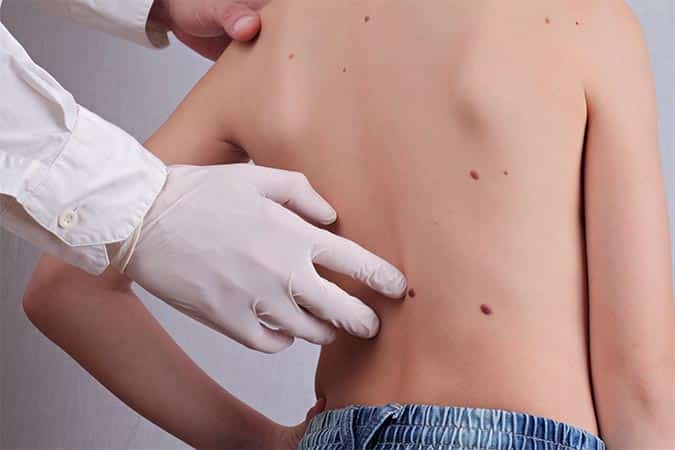What are Moles?
Moles, known as nevi to the medical community, are growths that appear on the skin. They can appear anywhere on the skin or mucous membranes, and range in color from the natural color of the skin to brown or black. Usually, moles appear during early childhood or the first 20 years of life, though they can sometimes appear later in adulthood. These growths occur when cells grow in a cluster instead of being spread out throughout the skin. After sun exposure, or during puberty moles can get darker.
In order to identify suspicious-looking moles, you should examine your child’s skin, or, if old enough, they should perform their own skin exam. Your pediatrician or family physician may suggest your child be seen by a dermatologist if they see unusual appearing moles. During a skin exam, be sure to pay attention to areas of the skin that are exposed to the sun often, such as the face, hands, legs, arms, chest, and back. To determine if a mole looks unnatural, follow the ABCDEs.
Asymmetry: If one half of the mole looks different than the other half.
Border: If the edges of the mole appear jagged, blurred, or irregular
Color: If the mole has many colors inside of it, including tan, brown, black, blue, red, or white
Diameter: If the diameter of the mole is larger than the size of a pencil eraser (6mm).
Evolution: If the mole changes over time.
Who is a Good Candidate for Mole Treatment?
While most moles are noncancerous, some may become a concern if they begin to look different from other existing moles. If you notice that your child has a mole that changes in appearance, bleeds, oozes, itches, or becomes painful, you should contact our office for an assessment.
What to Expect During Mole treatment?
If your dermatologist determines that all of your child’s moles are normal, then they do not need to be removed. Your dermatologist will often use a painless instrument, a dermatoscope, to better visualize the mole. However, if a mole is considered a concern, a skin biopsy will be done. During a biopsy, a small sample of the mole will be taken to examine under a microscope. This allows our dermatology team to make a diagnosis. If the mole is found to be very atypical or cancerous, it will need to be removed. There are two primary ways to remove a mole, including:
- Shave excision: During this procedure, your dermatologist will numb the area and then use a special tool to skillful remove the mole.
- Surgical excision: This procedure involves the cutting out of the entire mole under local anesthesia. Stitches are often needed to close the incision.
Mole FAQs
Are moles genetic?
Can a dermatologist tell if a mole is cancerous?
Can a mole itch and not be cancer?
Can moles be oval shaped?
How do doctors check if a mole is cancerous?
Following Mole Treatment
If your child needs to have a mole removed, downtime will vary depending on the size of the incision. Your dermatologist will do their best to minimize scarring. Be sure to follow your dermatologist’s instructions regarding recovery and post-surgery for the best possible results.
Schedule a Consultation
If you are concerned regarding a mole on your child, contact HMGS Dermatology today to schedule a consultation appointment. Our team of dermatologists and physician assistants are highly skilled in mole diagnosis and treatment, so you can be sure your child is in good hands.

Get Started With A Visit!
Fill out the form below and we will reach out to you shortly to schedule an appointment.